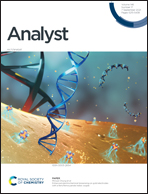The application of the inexpensive and synthetically simple electrocatalyst CuFe-MoC@NG in immunosensors†
Abstract
In this study, we used inexpensive and synthetically simple electrocatalysts as replacements for conventional precious metal materials to reduce hydrogen peroxide (H2O2). We for the first time developed N-doped graphene-coated CuFe@MoC using one-step calcination of binary Prussian blue analogues (PBAs) with Mo6+ cationic grafting precursors. The synergistic interaction of CuFe PBA and MoC increased the catalytically active sites for H2O2 reduction. The catalyst was optimized in terms of the ratio of CuFe PBA to Mo6+, PVP content, and calcination temperature to improve its catalytic activity. When it was used to construct an electrochemical immunosensor for carcinoembryonic antigen (CEA) detection, polydopamine (CuFe-MoC@NG@PDA) was coated on its outer surface to increase the antibody loading and MoS2–Au NPs were used as substrates to improve Ab1 immobilization and accelerate electron transfer at the electrode interface, thereby improving the response signal of the immunosensor. Its concentration was linearly related to the response signal from 10 fg mL−1 to 80 ng mL−1, and the lowest limit of detection was 3 fg mL−1. In addition, the immunosensor has acceptable selectivity and high stability. All data indicate that nanocomposites have electrocatalytic applications.



 Please wait while we load your content...
Please wait while we load your content...